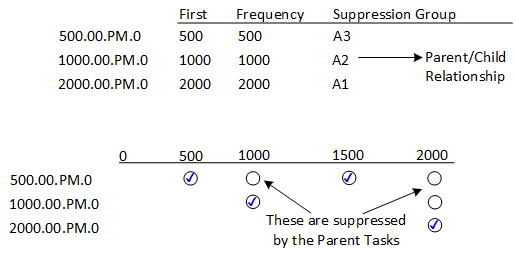Scheduling parameters - Parent suppression
If you have tasks which are associated with each other, for example, preventive maintenance services or child components of a major component where the major component is the engine, and the minor components are the turbos and radiator, a form of suppression logic may be appropriate.
Parent suppression logic is based on the performance of the PARENT task. Parent tasks suppress any children tasks if they fall within a certain tolerance of the parent task. The performance of the parent task implies that the child task has been performed as well, and therefore the component life of the child task is reset along with the parent’s.
With suppression, strategy tasks are grouped in a hierarchy so that A1 is the parent of A2 is the parent of A3 is the parent of A4 and so on. So when A1 occurs then this resets the life for all of its children. See the example below.

In this example, the three tasks are set up as preventive maintenance services, and are all within the suppression grouping “A”. The 2000 hour service is the highest member of the group (sequence number 1). The 1000 hour service is the child of the 2000 hour service, and the 500 hour service is the child of the 1000 hour service.
This example illustrates that child tasks of a parent task are suppressed when AMT schedules them to occur at the same time. Consequently, (in this example) at the 1000 life-cycle point, the 1000.00.PM.0 task is scheduled to occur. Therefore, the 1000.00.PM.0 task is sent through to AMT’s Planning module, and the 500.00.PM.0 is rescheduled based on that task’s Frequency parameter.